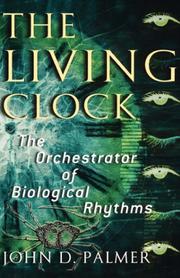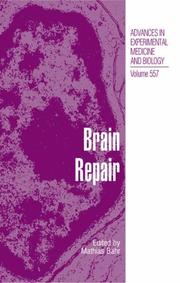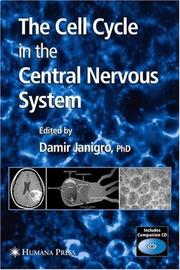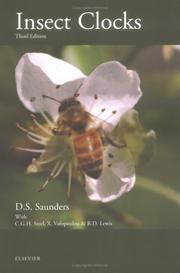| Listing 1 - 10 of 94 | << page >> |
Sort by
|
Multi
ISBN: 9781483217178 1483217175 0121528189 9780121528188 Year: 1981 Publisher: New York : Academic,
Abstract | Keywords | Export | Availability | Bookmark
 Loading...
Loading...Choose an application
- Reference Manager
- EndNote
- RefWorks (Direct export to RefWorks)
Current Topics in Cellular Regulation, Volume 18: Biological Cycles covers topics on the events of molecular biology, cellular communication, and the merging of cell structure to biochemical function. The book discusses the ornithin-urea cycle; the cycles of glutathione metabolism and transport; and the role of multienzymatic proteins in mammalian pyrimidine biosynthesis. The text also describes the significance of interconvertible enzyme cycles in cellular regulation; regulation of mammalian pyruvate dehydrogenase complex by a phosphorylation-dephosphorylation cycle; replenishment of citric
Biological rhythms --- Cells. --- Metabolism. --- Biological transport
Book
ISBN: 2759822710 9782759822713 Publisher: [Place of publication not identified] EDP SCIENCES.
Abstract | Keywords | Export | Availability | Bookmark
 Loading...
Loading...Choose an application
- Reference Manager
- EndNote
- RefWorks (Direct export to RefWorks)
Qu’est-ce que le temps ? L’écoulement du temps est-il une illusion ? Le temps a-t-il une flèche ? Peut-on voyager dans le temps ? Est-ce que le libre arbitre existe ou bien le futur est-il prédéterminé ? En s’appuyant sur les résultats les plus récents des neurosciences, ce livre expose comment on peut tenter de répondre aujourd’hui à ces questions. Le cerveau humain est un organe complexe qui ne se contente pas de percevoir le temps, il le construit. Il fabrique notre sens de la chronologie et c’est aussi une machine à explorer le temps qui nous permet de simuler les événements passés et futurs, une faculté qui a joué un rôle déterminant dans l’évolution de l’humanité. L’ouvrage combine neurosciences, physique et philosophie. La première partie décrit les différents types d’horloges biologiques qui permettent au cerveau de percevoir le temps. La deuxième partie est consacrée à la nature du temps et à la manière dont la physique en rend compte, en particulier dans le cadre des relativités d’Einstein. Le livre se conclut en développant les aspects psychologiques de la perception du temps et la façon dont la conscience fait le lien entre le passé et l’avenir.
Biological rhythms. --- Time --- Philosophy. --- Psychological aspects.

ISBN: 128053138X 9786610531387 0198032757 1602566682 9780198032755 9780195143409 019514340X 9781280531385 0195184580 9780195184587 0197701507 0190286644 Year: 2023 Publisher: New York ; Oxford University Press,
Abstract | Keywords | Export | Availability | Bookmark
 Loading...
Loading...Choose an application
- Reference Manager
- EndNote
- RefWorks (Direct export to RefWorks)
An introduction to a basic property of life, one mostly unknown to science and the public until the latter half of the last century: humans, plants, and animals have within their bodies a kind of clock that synchronizes much of what they do with the time of day, the seasons or the tides.
Chronobiology --- Biological time --- Biology --- Time --- Biological rhythms. --- Jet lag.
Book
ISBN: 1681082934 9781681082936 Year: 2016 Publisher: [Place of publication not identified] BENTHAM Science PUBLISHER
Abstract | Keywords | Export | Availability | Bookmark
 Loading...
Loading...Choose an application
- Reference Manager
- EndNote
- RefWorks (Direct export to RefWorks)
If you better understand what is at stake in jet lag, you will be better able to adjust harmoniously. Jet lag is reasonably well explained scientifically today. Rapid changes of time zones disturb the functioning of your body clock, which remains stubbornly set on departure time for a while. This can make sleep shallow or nonexistent for substantial parts of the night while vigilance is less than optimal during parts of the day. Flying west seems easier than flying east. Jet lag can in some cases be a more serious medical nuisance.
Biological rhythms. --- Flight --- Jet lag. --- Vigilance. --- Physiological aspects. --- Jet Lag --- Travel

ISBN: 128080419X 9786610804191 1423735099 0387301283 0306478595 Year: 2006 Volume: v. 557 Publisher: New York : Georgetown, Tex. : Springer Science+Business Media ; Eurekah.com/Landes Bioscience,
Abstract | Keywords | Export | Availability | Bookmark
 Loading...
Loading...Choose an application
- Reference Manager
- EndNote
- RefWorks (Direct export to RefWorks)
Brain Repair, addresses all relevant issues underlying the mechanisms of brain damage, brain plasticity and post-traumatic reorganization after CNS lesions. This book is divided the three major sections that follow; cellular and molecular basis of brain repair, plasticity and reorganization of neural networks, and experimental therapy strategies. Brain Repair is written by high profile, international experts who describe in detail the newest results from basic research and highlight new model systems, techniques and therapy approaches. Based on a careful analysis of the cellular and molecular reaction patterns of the CNS to lesions, the contributions cover possibilities for endogenous reorganization and repair as well as exciting new therapies emerging from basic research, some of which have already been introduced into the clinics. Thus, this book is unique in bridging the gap between basic and clinical research. It will be a valuable tool for all students, researchers and clinicians interested in understanding the brain's capacity to cope with lesions and interested in learning about emerging new therapy concepts.
Brain --- Cell cycle --- Apoptosis. --- Physiology. --- Regeneration. --- Cell death --- Mitotic cycle --- Nuclear cycle (Cytology) --- Biological rhythms --- Cerebrum --- Mind --- Central nervous system --- Head

ISBN: 1280971673 9786610971671 1597450219 158829529X Year: 2006 Publisher: Totowa, N.J. : Humana Press,
Abstract | Keywords | Export | Availability | Bookmark
 Loading...
Loading...Choose an application
- Reference Manager
- EndNote
- RefWorks (Direct export to RefWorks)
It is now known that the adult mammalian brain undergoes repair and renewal from pools of stem cells and that cell cycle alteration may cause a variety of neurological disorders ranging from autism to brain tumors. In The Cell Cycle in the Central Nervous System, prominent researchers, physicians, engineers, and pharmacologists join forces to delineate how the brain is a complex organ composed of widely varying cell types, including blood vessels, and what its cellular-based disorders may be. Topics covered range from the cell cycle during the prenatal development of the mammalian central nervous system (CNS) to future directions in postnatal neurogenesis through gene transfer, electrical stimulation, and stem cell introduction. Additional chapters examine the postnatal development of neurons and glia, the regulation of cell cycle in glia, and how that regulation may fail in pretumor conditions or following a nonneoplastic CNS response to injury. Highlights include treatments of the effects of deep brain stimulation on brain development and repair; the connection between the electrophysiological properties of neuroglia, cell cycle, and tumor progression; and the varied immunological responses and their regulation by cell cycle. State-of-the-art and readily understandable, The Cell Cycle in the Central Nervous System illuminates our understanding of how brain development, disease, renewal, and repair may be mediated by vasculogenesis, neurogenesis, and the immune system, and offers an exciting variety of new research opportunities for all those investigating brain tumors, neurodevelopment, and neurological disorders.
Central nervous system --- Cell cycle. --- Growth. --- Differentiation. --- Nervous system, Central --- Nervous system --- Mitotic cycle --- Nuclear cycle (Cytology) --- Biological rhythms --- Neurosciences. --- Neural sciences --- Neurological sciences --- Neuroscience --- Medical sciences
Book
ISSN: 0934943X ISBN: 1280716819 9786610716814 354032674X Year: 2006 Volume: 58 Publisher: Berlin : Springer,
Abstract | Keywords | Export | Availability | Bookmark
 Loading...
Loading...Choose an application
- Reference Manager
- EndNote
- RefWorks (Direct export to RefWorks)
It is our utmost pleasure to present a new book on tobacco BY-2 cells, Tobacco BY-2 Cells: From Cellular Dynamics to Omics, as the 58th volume in the book series Biotechnology in Agriculture and Forestry (BAF). It represents an extension of the previous book Tobacco BY-2 Cells,vol. 53 of the BAF. Moreover, the content is rather different from the latter and includes new topics, gleaned from the First International Symposium on Tobacco BY-2 Cells held at the Plant Science Center of the RIKEN, Yokohama, organized by Nagata, Matsuoka and Inze, in September 2004. To this symposium came more than 200 people from different parts of the world to discuss issues. Although most of the contributors to the previous volume of Tobacco BY-2 Cells gave talks on their subjects, there were many other speakers who presented new topics and approaches. So we enjoyed the symposium very much. Thus we decided to compile a new volume on tobacco BY-2 cells which includes these new topics. In addition, towards the end of the symposium, our common understanding was that the tobacco BY-2 cell system is still important in plant biology, in particular for studying the dynamic features of plant cells. We hope this volume is useful for plant biologists. Contents of the book are as follows: in Chapters I. 1–I. 6, various aspects of the cell cycle and cellular dynamics using BY-2 cells are described. In Ch- ters II. 1–II.
Plant cell cycle. --- Plant cells and tissues. --- Tobacco --- Cytology. --- Mahorka --- Makhorka --- Nicotiana tabacum --- Nicotiana --- Plant tissues --- Cells --- Plant anatomy --- Tissues --- Biological rhythms in plants --- Cell cycle

ISBN: 0444504079 9786611029524 1281029521 0080534716 9780444504074 9780080534718 Year: 2002 Publisher: Amsterdam ; Boston : Elsevier,
Abstract | Keywords | Export | Availability | Bookmark
 Loading...
Loading...Choose an application
- Reference Manager
- EndNote
- RefWorks (Direct export to RefWorks)
Chronobiology is the study of timing mechanisms in biological systems as diverse as plants, animals and some micro-organisms. It includes rhythmic phenomena ranging from short period (ultradian) through daily (circadian) to long period (monthly, annual) cycles of behaviour, physiology and biochemistry. In recent years spectacular advances have been made, particularly in the field of circadian rhythms, and hardly a week passes without important papers appearing in the major scientific journals. The third edition of Insect Clocks, like its predecessors, deals with the properties and
Insects --- Biological rhythms. --- Physiology. --- Behavior. --- Biological clocks --- Biology --- Biorhythms --- Endogenous rhythms --- Living clocks --- Rhythms, Biological --- Chronobiology --- Cycles --- Pacemaker cells --- Insect behavior --- Periodicity --- Insects - Physiology. --- Insects - Behavior.
Book
ISBN: 0674069692 0674065859 0674065484 9780674065482 9780674065857 9780674069695 Year: 2012 Publisher: Cambridge, MA
Abstract | Keywords | Export | Availability | Bookmark
 Loading...
Loading...Choose an application
- Reference Manager
- EndNote
- RefWorks (Direct export to RefWorks)
Early birds and night owls are born, not made. Sleep patterns may be the most obvious manifestation of the highly individualized biological clocks we inherit, but these clocks also regulate bodily functions from digestion to hormone levels to cognition. Living at odds with our internal timepieces, Till Roenneberg shows, can make us chronically sleep deprived and more likely to smoke, gain weight, feel depressed, fall ill, and fail geometry. By understanding and respecting our internal time, we can live better.Internal Time combines storytelling with accessible science tutorials to explain how our internal clocks work-for example, why morning classes are so unpopular and why "lazy" adolescents are wise to avoid them. We learn why the constant twilight of our largely indoor lives makes us dependent on alarm clocks and tired, and why social demands and work schedules lead to a social jet lag that compromises our daily functioning.Many of the factors that make us early or late "chronotypes" are beyond our control, but that doesn't make us powerless. Roenneberg recommends that the best way to sync our internal time with our external environment and feel better is to get more sunlight. Such simple steps as cycling to work and eating breakfast outside may be the tickets to a good night's sleep, better overall health, and less grouchiness in the morning.
Chronobiology. --- Biological rhythms. --- Biological clocks --- Biology --- Biorhythms --- Endogenous rhythms --- Living clocks --- Rhythms, Biological --- Chronobiology --- Cycles --- Pacemaker cells --- Biological time --- Time --- Periodicity
Book
ISBN: 1612098614 9781612098616 1607412519 9781607412519 Year: 2010 Publisher: New York
Abstract | Keywords | Export | Availability | Bookmark
 Loading...
Loading...Choose an application
- Reference Manager
- EndNote
- RefWorks (Direct export to RefWorks)
Biological rhythms. --- Circadian rhythms. --- Behavior, Circadian --- Biological clocks, Daily --- Circadian behavior --- Circadian clocks --- Circadian cycles --- Clocks, Circadian --- Cycles, Circadian --- Daily activity cycles --- Daily biological clocks --- Diel cycles --- Diurnal rhythms --- Rhythms, Circadian --- Biological rhythms --- Biological clocks --- Biology --- Biorhythms --- Endogenous rhythms --- Living clocks --- Rhythms, Biological --- Chronobiology --- Cycles --- Pacemaker cells --- Periodicity
| Listing 1 - 10 of 94 | << page >> |
Sort by
|

 Search
Search Feedback
Feedback About UniCat
About UniCat  Help
Help News
News